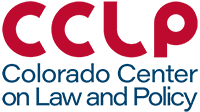A summary of the list of recommendations on the implementation of the OBBBA in Colorado regarding public benefits systems and work requirements.
Recent articles
CCLP testifies in support of Colorado’s AI Sunshine Act
Charles Brennan provided testimony in support of Senate Bill 25B-004, Increase Transparency for Algorithmic Systems, during the 2025 Special Session. CCLP is in support of SB25B-004.
Coloradans launch 2026 ballot push for graduated state income tax
New ballot measure proposals would cut taxes for 98 percent of Coloradans, raise revenue to address budget crisis.
CCLP statement on the executive order and Colorado’s endless budget catastrophe
Coloradans deserve better than the artificial budget crisis that led to today's crippling cuts by Governor Jared Polis.
CCLP testifies in support of fair standards in mental health care

On Wednesday, January 29, 2025, Andre Mansion, CCLP’s Associate Health Policy Director, provided written testimony to the House Health & Human Services Committee in support of House Bill 25-1002, Medical Necessity Determination Insurance Coverage. CCLP is in support of HB25-1002.
Dear Mr. Chair, Madam Vice Chair, and Committee Members:
The Colorado Center on Law and Policy (CCLP) thanks you for the opportunity to submit written testimony in support of House Bill 25-1002, Medical Necessity Determination Insurance Coverage. CCLP is an anti-poverty organization dedicated to advocacy, litigation, and research on areas including health, housing, income, and food. As such, we are invested in making sure that health insurers fulfill their promise to cover all “medically necessary” care, including behavioral and mental health treatment services.[1]
HB25-1002 is an important piece of legislation for ensuring and insuring the best care and best outcomes for Coloradans. This bill will prevent state-regulated commercial health plans from denying “medically necessary” services by allowing those with the appropriate knowledge and training to determine what “medically necessary” means. It also aligns coverage with existing state and federal parity laws.
As a clinical science psychologist, I have extensive knowledge on mental health issues and treatment. The following are several reasons why you should support this legislation:
- There Exists a High Prevalence of Mental Health Issues Among Colorado Residents.
Coloradans are in need of mental health services. Indeed, more than one in four (26.2%) Coloradans reported experiencing eight or more days of poor mental health in the past month in 2023.[2] Younger adults (18-50 years of age) are especially at risk, with over one in three adults reporting serious mental health challenges. These rates are greater than the national average of 23.1% and indicate a greater need for mental health care services among Colorado residents.[3]
- Treatments for Mental Health Disorders are Highly Efficacious.
There is robust scientific support for the effectiveness of evidenced-based mental health services for psychiatric conditions. Mental health treatment services provide symptom relief and personality change, reduce the risk for future symptoms, enhance quality of life, and promote healthy functioning at work, school, and in relationships.[4] Increasing coverage for mental health treatments will promote the utilization of these services, and lead Coloradans to have healthier and more fulfilling lives.
- Treating Mental Health Issues Costs Less Than Not Treating Mental Health Issues.
The treatment of mental health issues leads to lower total health costs over time for both individuals and insurers. Research shows that the use of mental health services reduces an individual’s overall medical costs and decreases overall utilization by decreasing the need for medical services over time. Indeed, those receiving mental health treatment saw a reduction in health care expenses of 17%. Whereas individuals who did not receive treatment for their mental health issues saw increases of 12.3% to their overall medical costs.[5]
- Mental Health Services are Underutilized by Coloradans.
In 2023, 17% of Coloradans with mental health care needs went completely without treatment.[6] This number is likely an underestimate of those who are not receiving meaningful care, as it does not include being under-treated or not receiving the most effective treatment, which is likely to occur when insurers do not cover recommended mental health care services. When asked what was preventing service utilization, Coloradans identified “cost” and “insurance coverage” as the second and third largest barriers to obtaining mental health care.
Insurers that offer health plans that guarantee coverage for mental health care services, but deny reimbursement for treatment that is recommended by a health care professional, endanger the mental, financial, and overall health of our residents. Support for this bill will protect Coloradans from these threats to their well-being by holding insurers accountable not only to their promises, but also to federal and state law. Given the increased need for, and effectiveness of, mental health services, and its association with decreased overall medical costs long-term, it is imperative that we improve access to mental health care by reducing costs to the individual and improving insurance coverage for mental health services. By supporting fair standards in mental health coverage, you place Coloradans on a path to a better quality of life.
For these reasons, CCLP emphatically urges the Health & Human Services Committee to vote yes on HB25-1002. Thank you for your time and attention.
Sincerely,
Andre D. Mansion, PhD, JD
Associate Health Policy Director
Colorado Center on Law and Policy
Update 2/18/2025: HB25-1002 will be heard in the Senate Health & Human Services Committee on February 20, 2025.
**********
[1] In the interest of brevity and ease of understanding, I will refer to the mental health treatments referenced in this bill (i.e., therapy, service, or intervention) collectively as “mental health services.”
[2] Colorado Health Access Survey (2023). 2023 Colorado Health Access Survey (CHAS): Mental Health. Colorado Health Institute. https://www.coloradohealthinstitute.org/research/2023-chas-mental-health.
[3] Substance Abuse and Mental Health Services Administration. (2023). Key substance use and mental health indicators in the United States: Results from the 2022 National Survey on Drug Use and Health (HHS Publication No. PEP23-07-01-006, NSDUH Series H-58). Center for Behavioral Health Statistics and Quality, Substance Abuse and Mental Health Services Administration. https://www.samhsa.gov/data/report/2022-nsduh-annual-national-report.
[4] American Psychological Association. (2012). Resolution on the effectiveness of psychotherapy. Retrieved from https://www.apa.org/about/policy/resolution-psychotherapy.
[5] Chiles, J.A., Lambert, M.J., & Hatch, A.L. (2002). Medical cost offset: A review of the impact of psychological interventions on medical utilization over the past three decades. In N. A. Cummings, W.T. O’ Donohue, & K.E. Ferguson (Eds.), The impact of medical cost offset on practice and research. Reno, NV: Context Press; Linehan, M.M., Comtois, K.A., Murray, A.M., Brown, M.Z., Gallop, R.J., Heard, H.L., et al. (2006). Two-year randomized controlled trial and follow-up of dialectical behavior therapy vs therapy by experts for suicidal behaviors and borderline personality disorder. Archives of General Psychiatry, 63, 757-766. DOI: 10.1001/archpsyc.63.7.757.
[6] Colorado Health Access Survey (2023). 2023 Colorado Health Access Survey (CHAS): Mental Health. Colorado Health Institute. https://www.coloradohealthinstitute.org/research/2023-chas-mental-health.
